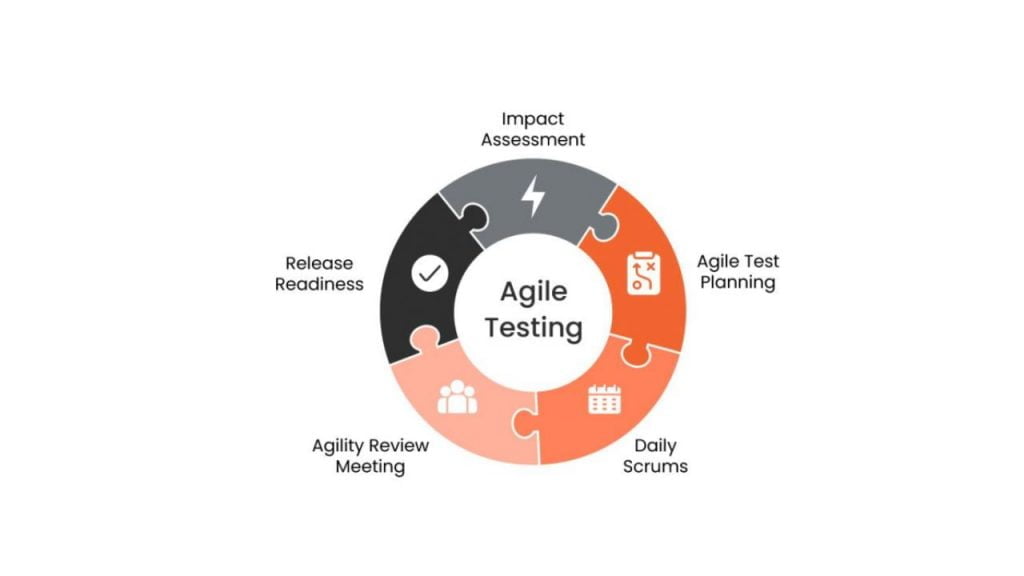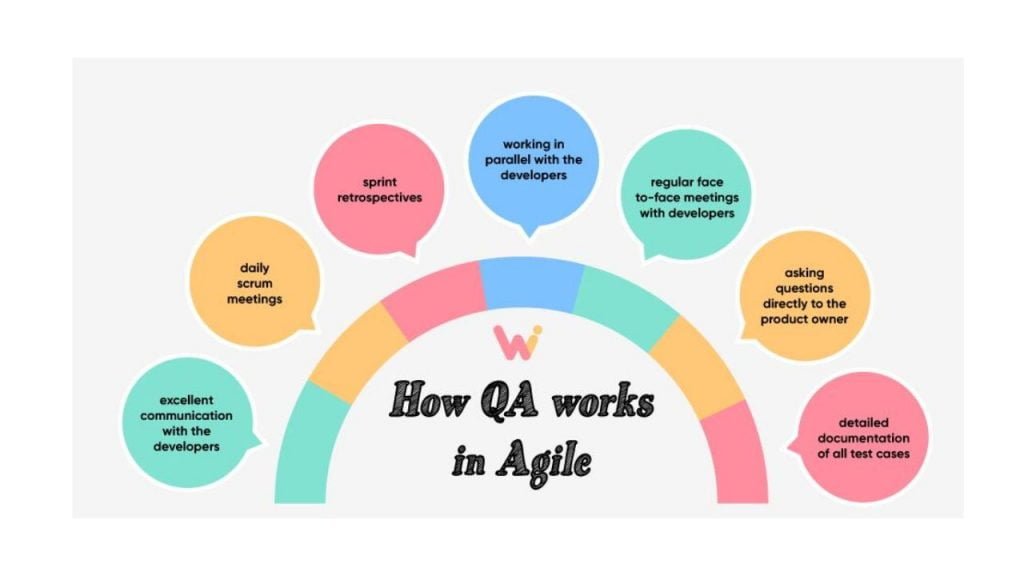One of the most crucial responsibilities in the software development process is quality assurance (QA) testing process. Without at least one Quality Assurance analyst, the team would not be complete in this process, and the project would not be tested and assessed.
If you have a strong QA team and a comprehensive QA process, you have the ability to produce and develop reliable products, with first gaining the customer’s trust and then the company’s credibility.
In this article we will explain what is Quality Assurance and the QA process in agile software development.
What is Agile?
Agile technique is one of the project management methodologies that divides the project into stages. These stages require constant stakeholder communication and development of the project. After the project starts, the QA team goes through a planning, development, evaluation and production process.
Collaboration and communication between the QA Team and stakeholders is essential. Agile also helps to save money, customer satisfaction and produce a quality product in a short time.
Many companies have moved from waterfall project development methodology to agile process. Agile testing engages QA testing at the earliest stage to anticipate problems early, write and execute test cases, and uncover issues with early intervention on the requirements part. In the phased process, QA can contact the team at any time and intervene and give feedback.
Agile QA Process

QA is an essential part of the software development lifecycle. Developers and other team members will use a QA process to assist in debugging, improving, and developing. The resulting product and service will be tried and tested with continuous feedback loops. This process requires a comprehensive strategy.
The Agile QA process is implemented from the very beginning of the SDLC. The process is repeated from the initial requirement and design meeting, through the final testing phase, to the delivery of the product. Software testing is done in continuous collaboration with developers throughout sprints and until the project is complete.
The testing step of the software development cycle is not just a part of the testing process. It participates in all phases of software development.
According to the World Quality Report 2022-23, the development and transformation of the quality assurance function from pure testing to actual quality engineering is needed now more than ever.
The most important goal in the Agile QA process is to provide the customer with continuous delivery by presenting the software to the customer in the earliest and continuously developing way.
This QA process gives the team the ability to develop projects, solve problems, eliminate errors, and produce new ideas. Not only the customer’s anticipated requests, but also the features that are made by considering the areas that can develop real problems and solutions are presented to the customer.
- Teams for the Agile QA process should typically consist of 5 to 10 persons. The QA team’s ability to break down the development process into manageable chunks (sprints) and provide a functional application to the client at the end of each sprint is one of their top priorities.
- If you use scrum framework the duration of a sprint can vary as 2 or 3 weeks. Every morning during the sprint, the whole team shares with other teammates what they did the previous day, what they will do today, if there is any problem, with a daily meeting of maximum 15 minutes, and updates them. If there is any problem, the scrum master removes this problem or It ensures that the problem is resolved by communicating with the person who will help in the team after the meeting.
- All operations and improvements to be made in sprints are divided into task steps (tasks) and distributed to team members over a certain platform. The analyst does the splitting of the features into tasks, but at the sprint planning meeting (the meeting held at the beginning of each sprint), all team members can make changes about the tasks by giving their opinion. Together with the team, the content of the tasks, the wishes of the customer, and how they can be done are discussed, and it is discussed how to improve them better.
- The tester tests tasks that have been finished throughout the sprint. Finding and fixing faults as soon as feasible while tests are being run during the sprint phase before the user appears is the feature that will be offered to the client. In the worst scenario, it is crucial to know that this is an error. The identified errors should be notified to the developer by creating a bug report, and the developer should then rectify them.
- Before the product is presented to the user, the tester should notify them that there is a problem in these parts, even if the product is ready.
- The timing and deadlines of the sprints have a positive effect on the performance of the team and the completion of the work. Sometimes, the fact that the tasks that need to be completed by the end of the sprint are not reached, can cause a pressure on the developers and test engineers. When it is the turn of the developer test engineer, who has finished his task on the last day, the time allocated for testing becomes very short and testing becomes difficult. The errors found as a result of the test should be discussed with the developer and necessary actions should be taken. Doing or not doing these in this tight time will reduce the quality of the test product.
- In Agile QA process project management, the QA team works together with Dev Teams and the whole team does their part. They are constantly communicating with each other, emphasizing feedback and improving features. The team looks for solutions by organizing Retro meetings for questions such as how we can be better, what we can produce or where we are doing wrong.
- In companies where project management is not applied within the Agile QA process, a person from the team contacts the relevant customer and learns what the customer wants, then opens a task on this subject and presents it to the developer. During this development process, no idea or opinion of any of the team members is taken and only the given work is done and presented to the customer.
- Agile QA process provides a better quality process in project management, providing a solution to the customer’s real problem rather than what the customer wants. Taking the opinions of all team members while solving the problem or processing the requests increases the product quality and customer satisfaction.
Test Engineer in The QA Process

- In the QA process, the test engineer in an Agile team should focus on how to prevent errors rather than finding errors. The Agile QA process is early tested in project management and begins at the earliest stage of the test development process.
- The test engineer in the Agile team must be able to quickly adapt to the ever-changing environment and features, have the perspective of the user and the customer, focus not only on fault finding but also on the quality of the product, analyze the system and integrate quickly, and have a very high and positive communication ability.
- The testing process proceeds in parallel with the implementation and development process. The two important processes after determining the requirements and preparing the tasks are the development and testing processes. This whole system is a whole and should proceed in this way. A test engineer needs to develop himself technically and speak the same language as the developer as required by the QA process.
- Not only the test engineer is responsible for the quality and error-free product, but the whole team is responsible.
- While test engineers perform their tests throughout the QA process, user-oriented tests should test the system by trying most of the possibilities that force the system to error in every way. It should perform tests in a way that reveals the error at the earliest stage.
- For an Agile team to be successful in the QA process, there must be strong team spirit and communication. They should work as a team, always be open and easily adaptable to new ideas and application development, and be in constant feedback. Team communication should be the top priority for the entire project.
When you start to implement this QA process, many positive benefits will be seen in the way your team works, in communication within the team, and in the speed of testing, developing and updating the software.
Conclusion
Companies using the QA process will have strong communication within the team, an application with a user perspective, customer trust, company reliability and successful and quality product delivery, which will eliminate 99% of the problems.
The QA process is the most preferred system because it has the features that include the most feedback and offers a fragmented working structure.
Nioyatech’s QA services has been a trusted testing partner for many organizations in various stages of adopting Agile.
Nioyatech’s approach integrates seamlessly into the development lifecycle while maintaining the critical separation between development and software QA processes. Their subject matter experts collaborate with you to select the appropriate frameworks and technologies to enable your QA strategy and integrate it into your development lifecycle.






